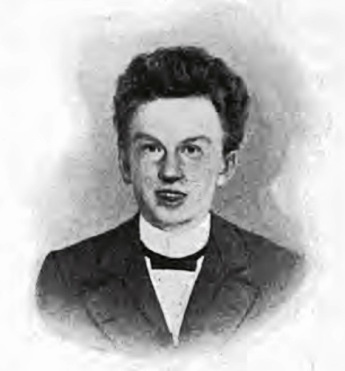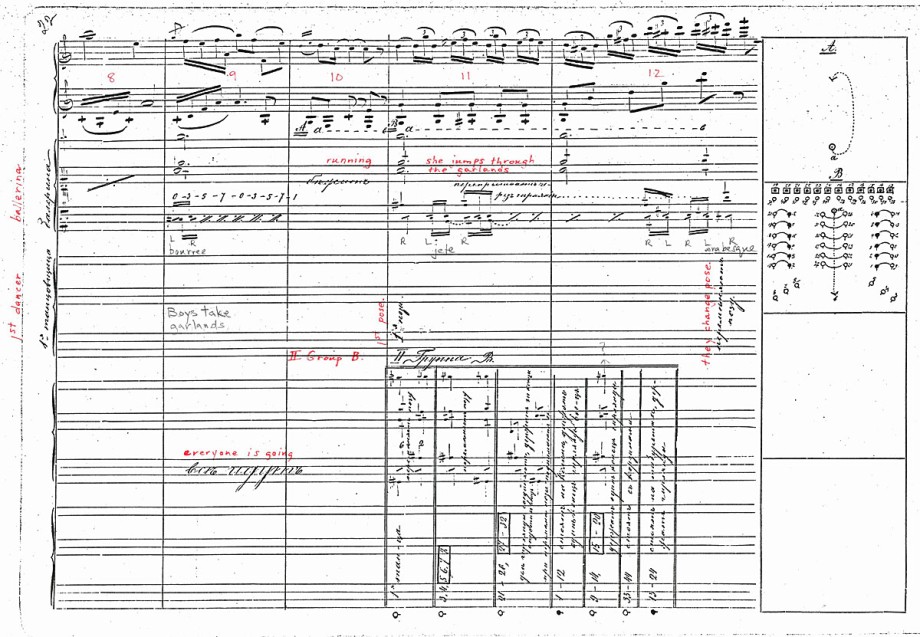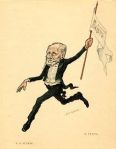The Sergeyev Collection is the collection that contains the choreographic notation scores, music, designs for décor and costumes, theatre programmes, photos and other materials for over twenty ballets from the Imperial Ballet repertoire. The collection is named after Nikolai Sergeyev, who served as the Imperial Ballet régisseur from 1903 to 1918.

History
In the 1890s, the dancer Vladimir Stepanov devised a new movement notation system which could allow the notation classical ballets. His book L’Alphabet des Mouvement du Corps Human was published in Paris in 1892 had included chapters on anatomy, gymnastics and choreography. By 1893, Stepanov proposed a project to the ruling committee of the Imperial Ballet School and its parent company, the Imperial Ballet, that would record the choreography of the company’s repertory for posterity. The committee of the imperial troupe of Saint Petersburg, consisted of J. Rioumie (State Councillor), M. Petipa, L. Ivanov, E. Vazem, P. Gerdt and C. Johansson. The committee required that Stepanov first present demonstrations, known as “certifications”, of the effectiveness of his method before the project would be fully implemented with state funding.

The first of these demonstrations was the notation of Ivanov and Riccardo Drigo’s one-act ballet The Magic Flute. Stepanov then presented a second demonstration of his method by mounting a reconstruction of Jules Perrot’s one-act ballet Le Rêve du peintre, originally staged in 1848 to the music of Cesare Pugni. The notations for this work were created by Stepanov after consulting Christian Johansson, who had participated in the 1848 production and many performances thereafter. The reconstruction of Le Rêve du peintre was performed by students of the Imperial Ballet School on 23th April [O.S. 2nd May] 1893. Based on the success of these notations, Stepanov’s project was approved and he soon began to notate the repertory of the Imperial Ballet. Among the first pieces to be documented was The Awakening of Flora and the scene Le Jardin Animé from Le Corsaire. Stepanov’s method of notation was also included for a time as part of the curriculum of students of the Imperial Ballet School.
After Stepanov’s death in 1896, Alexander Gorsky took over the notation project and perfected Stepanov’s system. After Gorsky departed Saint Petersburg in 1900 to take up the post of Ballet Master at the Bolshoi Theatre in Moscow, Sergeyev took over the project as supervisor. By 1903, Sergeyev was appointed régisseur of the Imperial Ballet. It was Sergeyev’s assistants who created the majority of the notation, all of whom were dancers with the imperial ballet: Alexander Chekrygin, Victor Rakhmanov, Nikolay Kremnev and S. Ponomaryev. The collection also includes notation created by students.

Following the outbreak of the Russian Revolution in 1917, Sergeyev and his wife were among those who fled to the west. They escaped in 1919, with Sergeyev taking all his notation scores with him. The notation scores were first put into use in 1920-21 when Sergei Diaghilev staged his production of The Sleeping Princess in London. Diaghilev commissioned Sergeyev to stage Petipa’s choreography using the notation scores. However, Diaghilev altered many of Petipa’s passages, which apparently led to Sergeyev withdrawing from the production. From then on, the notation scores would be used in various stagings of the classics all over Europe.
In 1924, Sergeyev utilised the scores when he was hired by Olga Spessivtseva to reconstruct Petipa’s final revival of Giselle for her performance at the Paris Opera House. He would stage Giselle again for Speesivtseva when he staged the production for the Camargo Society season at the Savoy Theatre in London in 1932. In 1938, at the invitation of Dame Ninette De Valois, Sergeyev was hired as Ballet Master for the Vic-Wells/Sadler’s Wells Ballet and utilised his scores to stage Giselle and The Sleeping Beauty the first full-length British productions of Swan Lake, The Nutcracker and Coppélia. In 1942, Sergeyev began staging classics for the International Ballet, a British touring company founded in 1941 by the ballerina Mona Inglesby, who offered to stage the productions as close as possible to Petipa’s imperial stagings.
After Sergeyev’s death in 1951, the notation scores were passed on for a brief time to one of his Russian associates, who later sold them to Inglesby, who continued to use them to stage productions of the classics for International Ballet until the company disbanded in 1953. Inglesby, through the London theatrical dealer Ifan Kyrle Fletcher, sold the Petipa/Ivanov Swan Lake notation to Harvard University in 1967, followed by the rest of the notations in 1969, for a sum claimed to be around £6,000. Today, the collection is known officially as the Nikolai Sergeev Dance Notations and Music Scores for Ballets, though it is commonly referred to simply as The Sergeyev Collection. For some time the notations were useless, as no one in the world had any knowledge of how to read Stepanov’s method. It was not until Stepanov’s original primer was found in the archives of the Mariinsky Theatre that the notations were able to be deciphered.
Not all of the notations are complete, with some being rather vague in sections, leading some historians who have studied the collection to theorize that they were probably made to function simply as “reminders” for the Ballet Master or régisseur already familiar with these works. Aside from the choreographic notations, the collection includes photos, set and costume designs and music for many of the ballets in their performance editions (mostly in piano and/or violin reduction), many of which include a substantial number of dances, variations, etc, interpolated from other works. One example of this is the music and notations for the ballet Le Corsaire, which contain additions from some of Petipa’s original works and revivals, some of which were no longer in the active repertory at the time the notations were prepared.
The Sergeyev Collection was first put to use for the first time in twenty years in 1984 by the British choreographer Sir Peter Wright and American historian Roland John Wiley when Wright staged his production of The Nutcracker for the Royal Ballet. This production is still performed by the company, though it has since been heavily revived from the original 1985 staging. It was not until 1999 that the collection was utilised for the first time in thirty years to stage a full reconstruction when Sergei Vikharev staged his reconstruction of The Sleeping Beauty at the Mariinsky Theatre. Since then, the Sergeyev Collection has been utilised by various choreographers and historians to stage reconstructions or new productions of Petipa’s ballets, including Doug Fullington, Yuri Burlaka, Vasily Medvedev and Alexei Ratmansky.
A full list of the collection’s contents can be seen here: Nikolai Sergeev dance notations and music scores for ballets, 1888-1944: Guide

Sources
- Fullington, Doug, Petipa’s Le Jardin Animé Restored. The Dancing Times: September, 2004. Vol. 94, No. 1129.
- Stepanov, Vladimir, Alphabet Des Mouvements Du Corps Humain: Essai D’enregistement Des Mouvements Du Corps Humain Au Moyen Des Signes Musicaux, 1892, M. Zouckermann Paris, France.
- Wiley, Roland John. Dances from Russia: An Introduction to the Sergeyev Collection Published in The Harvard Library Bulletin, 24.1 January 1976.
